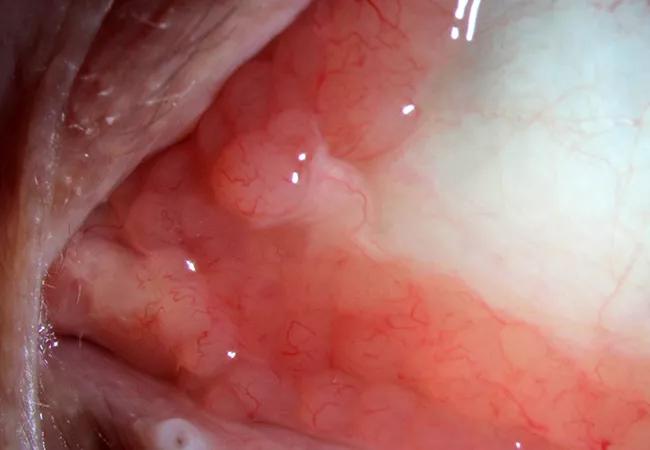Study confirms radiotherapy, rituximab as most effective

Results from a retrospective study of cases of rare ocular adnexal lymphoma (OAL) at Cleveland Clinic confirmed involved-field radiotherapy (IFRT) as the preferred treatment for localized disease, while single-agent intravenous rituximab is an effective therapy for more extensive disease, including bilateral or systemic extranodal marginal zone (ENMZ) lymphoma.
Advertisement
Cleveland Clinic is a non-profit academic medical center. Advertising on our site helps support our mission. We do not endorse non-Cleveland Clinic products or services. Policy
Researchers are continuing to evaluate the outcomes for patients with this rare disease, and will focus on limiting complications going forward.
“Ocular adnexal lymphoma is a rare entity and we expect approximately 2 to 5 percent of all lymphoma patients to have some kind of ocular adnexal involvement,” says Arun Singh, MD, Director, Ophthalmic Oncology, Cleveland Clinic Cole Eye Institute.

The ocular adnexa includes everything adjoined to the eyeball —eye lid, lacrimal gland, lacrimal sac and orbital muscles.
“The risk factors [for this disease] are the same as for general lymphoma — mostly it is age-dependent,” he says. “While some lymphomas are related to infections, infective agents such as chlamydia are not implicated for OAL.”
In the study, physicians evaluated the clinical characteristics and outcomes for 95 patients treated or diagnosed at Cleveland Clinic. In addition to confirming IFRT as the standard of care, the study concluded that combined modality therapy should be studied further in bilateral and systemic ENMZ OAL.
There are five main types of OAL–ENMZ lymphoma, lymphoplasmacytic lymphoma, follicular lymphoma, diffuse large B-cell lymphoma, and mantle cell lymphoma.
“The other rare kinds are usually anaplastic and typically more aggressive,” Dr. Singh says.
Extranodal marginal zone lymphoma is the most common type of adnexal lymphoma, accounting for approximately 70 percent of cases.
“ENMZ is a low-grade lymphoma, and that is fortunately the most common kind of OAL,” he says.
Advertisement
Biopsy and histopathology are critical in diagnosing the type of lymphoma in each patient. Once determined, it drives the selection of treatment.
“For ENMZ OAL, the treatments have varied over the years. Generally speaking, for adnexal lymphoma, if it’s just one site, just to the eye, one side, and there is no other systemic involvement with lymphoma, then low-dose radiation is a standard, approximately 25Gy,” Dr. Singh says. “We’re talking about 95 percent response rates.”
OAL can be part of a widespread lymphoma, or can become widespread over time.
“Radiation only works where you put it. It doesn’t protect the patients who are getting the lymphoma elsewhere,” says Dr. Singh. “So if you find multifocal disease — in both orbits and somewhere else in the body — then you think about intravenous rituximab. That’s the advantage of rituximab — if you think it’s multifocal disease, meaning the patient has the disease everywhere, the rituximab through the infusion will work everywhere.”
But there’s one catch.
“While the rituximab treatment is equally effective [as radiation], it requires multiple infusions and can be expensive. It’s more expensive than radiation for sure,” he says.
The issue with radiation is that it can cause certain complications, such as cataract, while other visual complications, such as radiation retinopathy, do not commonly occur.
“We feel that radiation is a good treatment; it has a very good control rate, but people shy away from it because they are concerned about complications,” Dr. Singh says. “So our ongoing research is to look at complications — complications such as radiation retinopathy. We are now studying complications and outcomes in our patients that have been treated at Cleveland Clinic over the last 10 to 15 years.”
Advertisement
Advertisement

First-of-its-kind research investigates the viability of standard screening to reduce the burden of late-stage cancer diagnoses

Global R&D efforts expanding first-line and relapse therapy options for patients

Study demonstrates ability to reduce patients’ reliance on phlebotomies to stabilize hematocrit levels

A case study on the value of access to novel therapies through clinical trials

Findings highlight an association between obesity and an increased incidence of moderate-severe disease

Cleveland Clinic Cancer Institute takes multi-faceted approach to increasing clinical trial access 23456

Key learnings from DESTINY trials

Overall survival in patients treated since 2008 is nearly 20% higher than in earlier patients